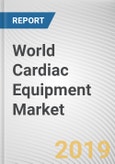The global cardiac equipment market is segmented on the basis of type and geography. On the basis of type, the market is segmented into, Balloon pumps, Cardiopulmonary bypass pumps, Cardiac ultrasound devices, Implantable Cardioverter Defibrillator (ICD), Cardiac Resynchronization Therapy (CRT) Devices such as CRT Pacemaker (CRT-P) and CRT Defibrillator (CRT-D), Defibrillators Pacemakers, Ventricular assist devices and others such as Total Artificial Heart and Counterpulsation Devices. Geographically, the market is segmented across four regions namely North America, Europe, Asia Pacific, and LAMEA.
New product approval and launch are among the few strategies adopted by top industry players. In April 2015, HeartWare International procured the Canadian marketing approval for HeartWare Ventricular Assist System, a small circulatory support device. Similarly, Philips has recently launched VesselNavigator, a 3D Navigation System intended for minimally invasive treatments of vascular diseases. In March 2014, St. Jude Medical announced the approval of three pacemakers, Allure Quadra CRT-P, Assurity and Endurity pacemakers. The companies profiled in this report include, Medtronic plc, Boston Scientific Corporation, St. Jude Medical, Inc., Thoratec Corporation, HeartWare Inc., SynCardia Systems, Inc., Vasomedical, Inc., Sorin Group, Biotronik, Inc. and Berlin Heart, Inc.
KEY MARKET BENEFITS
Comprehensive analysis of factors that drive and restrict the growth of the global market is provided
The market estimations are made in the report by conducting high-end analysis of the key market segments for the period of 2014-2020, which would enable the stakeholders to capitalize on prevailing market opportunities
Exhaustive analysis of the global cardiac equipment market, by type, helps in understanding the types of cardiac devices that are currently used along with the variants that would gain prominence in future
SWOT analysis enables to study the internal environment of the leading companies for strategy formulation
Region-wise market conditions are comprehensively analysed in the report
Competitive intelligence highlights the business practises followed by leading market players across the geographies
KEY MARKET SEGMENT:
The global cardiac equipment market is segmented below:
Global Market - By Type
Balloon pumps
Cardiopulmonary bypass pumps
Cardiac ultrasound devices
Implantable Cardioverter Defibrillator (ICD)
Cardiac Resynchronization Therapy (CRT) Devices
CRT Pacemaker (CRT-P)
CRT Defibrillator (CRT-D)
Defibrillators
Pacemakers
Ventricular assist devices
Others
Total Artificial Heart
Counterpulsation Devices
Global Market - By Geography
North America
Europe
Asia-Pacific
LAMEA
Methodology
The analyst offers exhaustive research and analysis based on a wide variety of factual inputs, which largely include interviews with industry participants, reliable statistics, and regional intelligence. The in-house industry experts play an instrumental role in designing analytic tools and models, tailored to the requirements of a particular industry segment. The primary research efforts include reaching out participants through mail, tele-conversations, referrals, professional networks, and face-to-face interactions.
They are also in professional corporate relations with various companies that allow them greater flexibility for reaching out to industry participants and commentators for interviews and discussions.
They also refer to a broad array of industry sources for their secondary research, which typically include; however, not limited to:
- Company SEC filings, annual reports, company websites, broker & financial reports, and investor presentations for competitive scenario and shape of the industry
- Scientific and technical writings for product information and related preemptions
- Regional government and statistical databases for macro analysis
- Authentic news articles and other related releases for market evaluation
- Internal and external proprietary databases, key market indicators, and relevant press releases for market estimates and forecast
Furthermore, the accuracy of the data will be analyzed and validated by conducting additional primaries with various industry experts and KOLs. They also provide robust post-sales support to clients.

LOADING...








